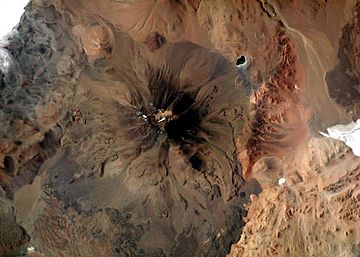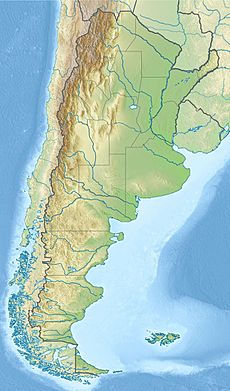Aracar facts for kids
Quick facts for kids Aracar |
|
|---|---|

Aracar from the Space Shuttle, January 2003
|
|
| Highest point | |
| Elevation | 6,095 m (19,997 ft) |
| Prominence | 1,791 m (5,876 ft) |
| Parent peak | Ojos del Salado |
| Listing | Ultra |
| Geography | |
| Parent range | Andes |
| Geology | |
| Age of rock | Pliocene |
| Mountain type | Stratovolcano |
| Last eruption | 1993 |
| Climbing | |
| First ascent | 04/01/1958 - Yosko Cvitanic (Yugoslavia), Gustav Lanstchner and Emo Henrich (Austria) |
Aracar is a huge, cone-shaped stratovolcano in northwestern Argentina. It sits very close to the border with Chile. This volcano has a main crater at its top that is about 1 to 1.5 kilometers (0.6 to 0.9 miles) wide. Sometimes, this crater fills with water, forming a crater lake. Aracar also has a smaller, secondary crater.
This volcano started forming millions of years ago, during a time called the Pliocene epoch. It grew on top of older rock layers and a platform made of hardened lava. The base of Aracar is already very high, at about 4,100 meters (13,450 feet) above sea level. The volcano itself covers a large area of about 192 square kilometers (74 square miles).
People have only seen one possible volcanic event from Aracar. On March 28, 1993, people in the village of Tolar Grande, about 50 kilometers (31 miles) away, saw what looked like a cloud of steam or ash rising from the volcano. However, satellite pictures didn't show any changes to the volcano's shape, so it's not certain if it was a true eruption or something else, like a landslide. Ancient Inca people built special sites on Aracar, showing its importance to them.
What is Aracar Made Of?
Aracar is located in the Salta province of Argentina. It's found among many salt flats, like the Salar de Taca Taca and Salar de Arizaro, and is near the Chilean border. The land around Aracar has many volcanoes and dry lakebeds.
The ground beneath Aracar is made of very old rocks, including granite from the Paleozoic era. The volcano itself is a large cone, about 13.5 kilometers (8.4 miles) wide. It has a somewhat rectangular base, measuring between 12 and 18 kilometers (7.5 to 11 miles) across.
Aracar is a "polygenetic" volcano, meaning it formed from many eruptions over time. It has four smaller lava domes that stretch out to the southeast. The sides of the volcano are covered in grey basaltic lava flows. The western side is gently sloped, while the eastern, northern, and southern sides are much steeper.
The main crater on Aracar's summit is quite large and deep. Sometimes, melting snow creates small, temporary lakes inside this crater. There's also a smaller, shallower secondary crater. Over time, erosion has carved deep valleys into the volcano, and Moraines (piles of rock and dirt left by glaciers) can be seen, especially on the eastern side.
The lower parts of Aracar are made of old lava flows that spread out for many kilometers. These flows filled in the landscape that was there before. The main cone of the volcano, which is about 900 meters (2,950 feet) tall, grew on top of these older lava layers.
The rocks from Aracar's lava flows are usually dark grey or black. They often have small crystals inside them, like plagioclase and pyroxene. These rocks are similar to those found in other volcanoes in the Central Volcanic Zone of the Andes. Scientists believe the magma (molten rock) that formed Aracar came from a magma chamber deep underground.
Scientists are still learning about Aracar's full history. The oldest lava flows are millions of years old. It's thought that liquid basaltic lavas erupted first, followed by other types of lava. Aracar is considered one of Argentina's more dangerous volcanoes, ranking 17th out of 38.
History and People
The first recorded climb of Aracar was in 1958 by European climbers, including Mathias Rebitsch. During their climb, they discovered an archeological site near the summit. Unfortunately, some areas on the northeastern side of Aracar have mine fields, which makes it impossible to explore those parts.
A significant Inca archeological site is located on Aracar. There are two main areas: one on the summit and another at the secondary crater. The summit site has a stone circle and low stone walls, placed just above the slopes leading into the main crater. The site at the secondary crater is a terrace-shaped stone structure built into its slopes, with a smaller terrace nearby.
Around these stone structures, explorers have found timber and wood. All these ancient sites are relatively small, no more than 5 meters (16 feet) across. These structures might have been a sanctuary where people could gather for ceremonies, possibly in areas protected from the wind.
See also
 In Spanish: Volcán Aracar para niños
In Spanish: Volcán Aracar para niños


